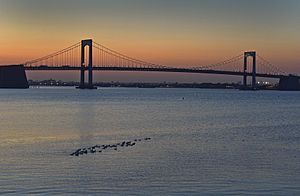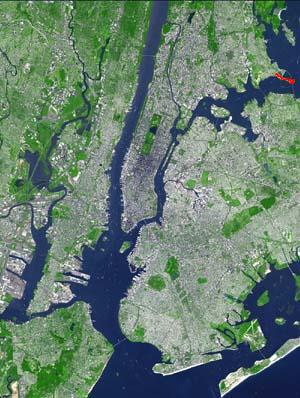Throggs Neck facts for kids
Quick facts for kids
Throggs Neck
|
|
|---|---|
|
Neighborhood of the Bronx
|
|

Throgs Neck Bridge
|
|
| Country | |
| State | |
| City | New York City |
| Borough | The Bronx |
| Community District | Bronx 10 |
| Area | |
| • Total | 4.93 km2 (1.903 sq mi) |
| Population
(2011)
|
|
| • Total | 21,009 |
| • Density | 4,262.5/km2 (11,040/sq mi) |
| Economics | |
| • Median income | $69,003 |
| ZIP Codes |
10465
|
| Area code | 718, 347, 929, and 917 |
Throggs Neck (also spelled Throgs Neck) is a neighborhood and a piece of land that sticks out into the water (a peninsula) in the southeastern part of the Bronx in New York City. It is surrounded by the East River and Long Island Sound to the south and east. To the west, it borders Westchester Creek, and to the north, it meets Baisley Avenue and the Bruckner Expressway.
This neighborhood is part of Bronx Community Board 10, and its ZIP Code is 10465. The New York City Police Department's 45th Precinct helps keep Throggs Neck safe.
Contents
- Exploring Throggs Neck's Location
- The Story Behind the Name
- A Look Back at Throggs Neck's Past
- Who Lives in Throggs Neck?
- Keeping Throggs Neck Safe
- Mail and Post Office Services
- Learning in Throggs Neck
- Getting Around Throggs Neck
- Throggs Neck in Movies and TV
- Famous People From Throggs Neck
- Images for kids
- See also
Exploring Throggs Neck's Location
Throggs Neck is a narrow strip of land in the southeastern part of the Bronx, a borough of New York City. It marks the spot where the East River (which is like a river mixed with ocean water) meets Long Island Sound. The neighborhood itself is also called "Throggs Neck." It is bordered by Baisley Avenue and the Bruckner Expressway to the north, Westchester Creek to the west, and the East River and Long Island Sound on its other sides.
The neighborhood is near the Throgs Neck Bridge, which connects the Bronx to Bay Terrace in Queens on Long Island. The Throgs Neck Lighthouse used to stand at the very tip of the land. The Bronx–Whitestone Bridge also has its northern entrance in the Throggs Neck area. A large green space called Ferry Point Park is split by the Bronx/Whitestone Bridge. One side has fields for sports like soccer and cricket, plus a ferry stop. The other side has a walking path, a golf course, and a restaurant by the water.
The Story Behind the Name
The name "Throggs Neck" comes from the last name "Throckmorton." Over time, people have spelled it differently, sometimes with one "G" and sometimes with two. The older, traditional way to spell it is with two "Gs."
There's a fun story that says Robert Moses, a famous city planner, officially changed the spelling to one "G" when the Throgs Neck Bridge was being built. He supposedly thought two "Gs" wouldn't fit on many street signs. However, many people who have lived in the area for a long time still prefer the traditional spelling with two "Gs."
A Look Back at Throggs Neck's Past
The Dutch settlers, who came to this area first, called the peninsula Vriedelandt, which means "Land of Peace." The current name comes from John Throckmorton, an English settler who came here in 1642 with about 35 other people. At one point, the area was also known as Maxson's Point because the Maxson family lived there. Sadly, many settlers, including Anne Hutchinson and her family, were killed in a conflict with Native Americans in 1643. Throckmorton later went back to Rhode Island. By 1668, maps showed the peninsula as "Frockes Neck." At high tide, this piece of land was almost like an island.
During the American Revolutionary War in 1776, George Washington's army thought the British might try to land at "Frogs Neck." General Howe, a British leader, tried to cut off Washington's troops near a bridge over Westchester Creek. But the Americans quickly removed the bridge planks and fired at the British, forcing Howe to change his plans. He landed his troops elsewhere a few days later.
In the 1800s, Throggs Neck was mostly large farms that later became fancy estates. The Morris family bought a big piece of land around 1848 and built two large houses and many smaller buildings. Their estates had a private dock on Morris Cove. After the Civil War, Collis P. Huntington, who built railroads, owned a huge property here. His family kept it for a long time. The mansion on Huntington's property is now Preston High School.
From 1833 to 1856, workers came to build Fort Schuyler. Many of these workers were immigrants from Ireland who settled in the area. By the late 1800s, Throggs Neck became a popular summer vacation spot. People from other parts of New York City would come by steamboat to enjoy the seaside and large German beer gardens.
In the 1920s, many of the large estates were divided into smaller plots for row homes and bungalows. Two families, the Peters and Sorgenfrels, created Silver Beach Garden, a summer community of bungalows. These bungalows were later updated for people to live in all year round. Nearby, a church youth camp also became a bungalow community called Edgewater Park.
In 1932, Fort Schuyler stopped being a military base and became the campus for the State University of New York Maritime College. In 1961, the construction of the Throgs Neck Bridge and nearby highways made the neighborhood less isolated. Unlike many parts of the Bronx, Throggs Neck mostly avoided the serious problems that affected the city in the 1970s.
Who Lives in Throggs Neck?
Throggs Neck has different types of homes, including houses for middle-class families and fancy waterfront apartments (condominiums). It also has the Throggs Neck Houses, which were built in 1953 as one of the first public housing projects in New York City. In the 1980s, people described Throggs Neck as one of the last middle- and upper-middle-class areas in the Bronx, feeling like a well-kept suburb.
According to the 2010 Census, about 44,167 people lived in the Schuylerville, Throgs Neck, and Edgewater Park areas. The neighborhood is quite diverse. About 46% of residents were White, 7.9% African American, and 41% were Hispanic or Latino of any race.
Most people in Community District 10 (which includes Throggs Neck) are young or middle-aged adults. About 20% are under 18, 26% are between 25 and 44, and 27% are between 45 and 64. The average life expectancy in this area is about 81.1 years, which is similar to the rest of New York City.
Keeping Throggs Neck Safe
The New York City Fire Department (FDNY) has two fire stations that serve Throggs Neck. Engine Co. 89/Ladder Co. 50 is located on Bruckner Boulevard, and Engine Co. 72/Satellite 2 is on East Tremont Avenue.
Mail and Post Office Services
Throggs Neck uses the ZIP Code 10465. The United States Postal Service's Throggs Neck Station, where you can send and receive mail, is located at 3630 East Tremont Avenue.
Learning in Throggs Neck
In Community District 10, fewer residents have a college degree compared to the rest of New York City. About 34% of adults aged 25 and older have a college education or higher. However, the percentage of elementary school students doing well in math increased from 29% in 2000 to 47% in 2011. Reading skills also improved during the same time.
About 21% of elementary school students in Community District 10 miss 20 or more days of school each year. For high school students, about 75% graduate on time, which is the same as the city average.
Schools in the Neighborhood
The New York City Department of Education runs several public schools in Throggs Neck:
- PS 10 (grades PK-8)
- PS 72 Dr William Dorney (grades PK-5)
- MS 101 Edward R Byrne (grades 6–8)
- PS 304 Early Childhood School (grades PK-5)
- Hospital Schools (grades K-12)
- Mott Hall Community School (grades 6–8)
There are also private schools in Throggs Neck:
- St Frances De Chantal School (grades PK-8)
- Preston High School (grades 9–12)
- Monsignor Scanlan High School (grades 9–12)
- St Benedict School (grades PK-8)
Local Library
The New York Public Library has a branch called Throg's Neck. It is located at 3025 Cross Bronx Expressway Extension. This library has been open since 1954 and moved to its current building in 1974.
Getting Around Throggs Neck
You can get around Throggs Neck using several MTA Regional Bus Operations bus routes:
- Bx5: Travels to Pelham Bay Park and Bay Plaza Shopping Center or the Simpson Street subway station.
- Bx8: Goes to the 225th St station or Locust Point.
- Bx40/Bx42: Connects Throggs Neck to Morris Heights.
- Q44 SBS: An express bus that goes to Jamaica, Queens or the Bronx Zoo.
- Q50: Travels to Flushing, Queens or Co-op City.
- BxM9: An express bus that goes to Midtown Manhattan.
A new ferry stop, Throgs Neck Landing, opened on December 28, 2021, as part of NYC Ferry's Soundview route.
The Throgs Neck Bridge and the Whitestone Bridge make it easy to travel to Queens and Long Island. Throggs Neck also has good access to major highways like the Hutchinson River Parkway, the Bruckner Expressway, and the Cross-Bronx Expressway. This makes it convenient to reach Throggs Neck from many parts of the New York area.
Many streets near the southern end of Throggs Neck are named after Union generals from the American Civil War, like Philip Kearny and Carl Schurz. One road is even named after James Longstreet, a Confederate general who later supported the rebuilding of the South after the war.
Throggs Neck in Movies and TV
Several movies and TV shows have been filmed in Throggs Neck, including:
- Awakenings (1990)
- Summer of Sam (1999)
- Episodes of Law & Order: Special Victims Unit
- Storage Wars: New York
- Scenes in The Leftovers
Famous People From Throggs Neck
- Frank Bello (born 1965), bass player for the band Anthrax
- Charlie Benante (born 1962), drummer for the band Anthrax
- Collis Potter Huntington (1821–1900), a famous railroad builder
- Christine Jorgensen (1926–1989), known for being one of the first people to have gender confirmation surgery
- Michael Kay (born 1961), a sports announcer
- Doug Marrone (born 1964), a football coach
- Sal Mineo (1939–76), an actor
- Bill Polian (born 1942), a Hall of Fame executive in the National Football League
- T.J. Rivera (born 1988), a baseball player for the New York Mets
- Ritchie Torres (born 1988), a Congressman from New York
Images for kids
See also
 In Spanish: Throggs Neck (Bronx) para niños
In Spanish: Throggs Neck (Bronx) para niños




